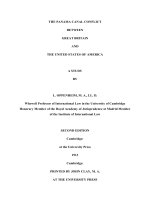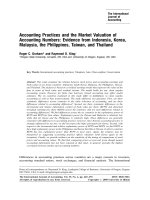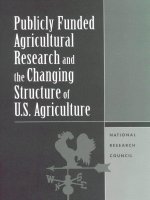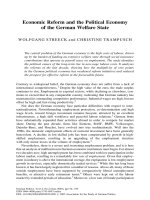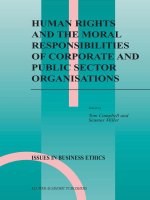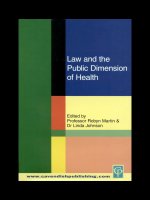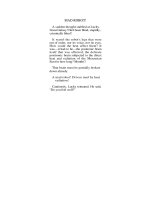Becoming bodhisattvas practices and the popular discourse of kuan yin in kuala lumpur
Bạn đang xem bản rút gọn của tài liệu. Xem và tải ngay bản đầy đủ của tài liệu tại đây (1.76 MB, 336 trang )
BECOMING BODHISATTVAS: PRACTICES AND THE
POPULAR DISCOURSE OF KUAN-YIN IN
KUALA LUMPUR
CHIA CHEE KAIN, ARTHUR
(M.A. SOUTHEAST ASIAN STUDIES, NUS)
A THESIS SUBMITTED
FOR THE DEGREE OF DOCTOR OF PHILOSOPHY
SOUTHEAST ASIAN STUDIES
DEPARTMENT OF SOUTHEAST ASIAN STUDIES
NATIONAL UNIVERSITY OF SINGAPORE
2012
ii
DECLARATION
I hereby declare that this thesis is my original work and it has been written by me in
its entirety. I have duly acknowledged all the sources of information which have been
used in the thesis.
This thesis has also not been submitted for any degree in any university previously.
___________________________
CHIA CHEE KAIN, ARTHUR
30 JUNE 2012
iii
Acknowledgements
This thesis was made possible by the NUS Research Scholarship and
Department of Southeast Studies, National University of Singapore.
I am thankful to my thesis advisor Goh Beng-Lan for her tremendous patience,
guidance and support. I am also grateful for the encouragement and support of Irving
Johnson and Julius Bautista who have been part of my Ph.D. committee.
The small but vibrant community of graduate students at the Department of
Southeast Asian Studies, NUS has been a great source of learning and friendship
especially with Idham Setiadi, Soon Chuan Yean, Leong Kar Yen, Danny G. Tan and
Budi Irawanto.
I have also benefitted from the conferences and seminars at NUS and the Asia
Research Institute (ARI). The Graduate Research Seminar under the stewardship of
Reynaldo C. Ileto or “Prof. Rey” as we students would call him, was particularly
formative in my scholarship.
I am deeply grateful to Chee Heng Leng at ARI, Graham Jones at MIT, Kristin
Wood and Christopher Magee at the Singapore University of Technology and Design
for their generosity and kindness during the critical stages of this project.
iv
To my Bodhisattva friends in Kuala Lumpur who have shown so much
hospitality and enthusiasm without which this thesis will never be possible, I am
deeply thankful.
Finally, I dedicate this thesis to my family for their understanding and patience
in support of my “graduate career”. No sacrifice is greater than a mother’s and I am
eternally grateful to my mother for hers without which this project will never be
possible.
v
Table of Contents
DECLARATION ii
ACKNOWLEDGEMENTS iii
SUMMARY vi
INTRODUCTION 1
CHAPTER 1 38
Outline of a “possible history”
CHAPTER 2 68
KYCO: an overview
CHAPTER 3 109
Charismatic and moral leadership: Sifu Tony Wong
CHAPTER 4 140
Bodhisattvas of Kuala Lumpur
CHAPTER 5 166
Self-Cultivation: praying, singing, chanting, listening,
writing and contemplating
CHAPTER 6 209
Contemplation
CHAPTER 7 239
Moral Conundrums
CONCLUSION 267
BIBLIOGRAPHY 276
APPENDICES 287
vi
Summary
Entitled Becoming Bodhisattvas: practices and the popular discourse of Kuan-
yin in Kuala Lumpur, this thesis offers a glimpse into the spiritual life of ordinary
Kuan-yin devotees by examining the production of virtues and moral habits among a
group of Chinese middle-class followers who belong to a Kuan-yin venerating
association in the suburbs of Petaling Jaya, Kuala Lumpur. The attainment of a
particular set of personal ethical skills, outlook and disposition aside from the
preservation of good health, prosperity etc. is an aspiration that they strive towards.
Like the pursuit of longevity, wealth and fortune, this aspiration is perceived to be
elusive yet attainable. I argue that the spiritual life is a challenging enterprise deeply
rooted in cultural, religious and moral practices.
The thesis attempts to establish an understanding of how this spiritual
aspiration – which I describe in my work as “Bodhisattva-hood”, is manifested,
reproduced and embodied. Using ethnographic and historical methods, I explore the
inner world of deep spiritual and/or religious conviction mainly along the notion of
“practice” in a production of human qualities and virtues that focuses on the ways
people construct and experience spiritual ideologies and values.
1
Introduction
I had never participated in a street procession before, so I readily agreed to
join in the Vesak
1
day march of 2008. No prior registration was needed and no forms
to be filled. I just needed to show-up at the Maha Vihara Buddhist temple in
Brickfields, Kuala Lumpur Malaysia. The only prerequisite was to come in a white
attire. I was not sure what to expect. On the day of the procession, I took the inter-
city train to Brickfields, away from the suburb of Petaling Jaya where most of my
fieldwork was based. When I reached Maha Vihara – a modest Buddhist temple
complex consisting of several low-rise buildings in the middle of a high-rise
residential compound with neighboring Hindu temples, Chinese shrines and a
Lutheran church, I found myself amidst a swelling crowd of thousands of Vesak day
marchers who had already gathered by the road outside the temple. People were
milling around, the atmosphere was casual and relaxed, everyone was in high spirits
and there was no police presence. The mood was festive with temporary roadside
vendors doing a brisk business of selling cold drinks, snacks and palm-size miniature
lotus-shaped candles that devotees would light and carry along during the march. The
lotus is one of the most recognized motifs of Buddhism. It appears in many Buddhist
art across cultures: important Buddhist deities are often depicted in one way or
1
Vesak is a holiday observed by Buddhists in many countries. Vesak commemorates the birth,
enlightenment and passing away of the Buddha. It falls on the full moon day which is typically during
the fifth or sixth lunar month of the year.
2
another with the lotus, either sitting in a lotus in full bloom or holding a stalk of lotus
in one of their hands. For Buddhists, the lotus symbolizes purity and compassion – it
is rooted in mud; its stem growing through murky water blooms into a beautiful
heavily scented flower above the muck signifying spiritual progress from suffering to
enlightenment. The lotus bears tremendous significance for the Mahayana Buddhist
tradition, particularly as an important teaching known as the Lotus Sutra. It
symbolizes for many Buddhists what it means to be “in the world but not of the
world”.
Within a few moments my friends from Kuan-Yin Contemplative Order – a
lay Buddhist organization or “KYCO” as followers call it, found me in the sea of
devotees. They stood out in their crisp all-white attire looking fresh and clean. There
were eleven of us from KYCO that evening. Swee Kiat
2
, one of the most active
members of KYCO and the coordinator for this outing, was happy to see me there and
delighted that I had worn the white KYCO t-shirt as well. Someone from the group
pointed at my blue cap and said with good humor, “You look like you are from
UMNO”. It was a stark reminder of the recent watershed general election of March
2008 which saw the biggest loss for the ruling Malay party UMNO in its history (but
2
With respect to religious sensitivities in Malaysia, most names in this thesis are pseudonyms.
3
still maintaining a precarious majority
3
). I was perplexed by that insinuation but it
reminded me of my place as an “outsider”. I tried to explain that it was meant to keep
my unkempt greasy hair away from the face but realized that the cap was probably
inappropriate and tucked it away in my bag.
At exactly 7pm, someone stood on a makeshift raised platform to make an
announcement which I could not hear. By now, the gathering crowd had spilled onto
the main road of Jalan Tun Sambanthan which had been cordoned off to facilitate the
procession. People started walking along the road and there were several distinct
groups: a Burmese contingent of lay-followers held a banner announcing and
identifying themselves; a contingent of uniformed Chinese youths from the Young
Buddhist Association of Malaysia unfurled a gigantic six-color Buddhist flag began
marching and singing Mandarin Buddhist hymns; there was also a contingent that
comprised of Tibetan monks in saffron robes and their followers, and we were
instructed to march together with them. There were brightly-lit floats mounted on
lorries depicting scenes of the Buddha’s Birth and Enlightenment while others were
3
UMNO stands for United Malay National Organization. It is the dominant political party amongst 14
other parties organized along ethnic and communal lines, in the ruling coalition Barisan Nasional (BN).
Other component parties of BN include the Malaysian Chinese Association (MCA), Malaysian Indian
Congress (MIC), Gerakan Rakyat Malaysia (Gerakan or Malaysia’s Peoples Movement). During the
general election of March 2008, BN lost its two-thirds majority in the Dewan Rakyat (House of
Representatives), which it had held since independence in August 1957 with 82 parliamentary seats and
five states going to a newly formed coalition, the Pakatan Rakyat (People’s Alliance or PR) led by
former Deputy Prime Minister Anwar Ibrahim. The election marked the start of a period of political
instability and power struggles between and within these two political groups. See also “Malaysia in
2009: Confronting Old Challenges through a New Leadership” (Bilveer Singh 2010).
4
decorated with larger-than-life effigies of “Fu-Lu-Shou” (Chinese Gods of Prosperity,
Good Fortune and Longevity).
There was a lot of fanfare around us as we marched along the ten-kilometer
route and I took in the sights of iconic landmarks of the city such as the Kuala
Lumpur Railway Station, Merdeka Square, Masjid Jamek (Central Mosque), Central
Market, National Museum etc. However, the mood in my group was subdued and
somber in contrast to the joyous singing and easy camaraderie amongst other
marchers. Swee Kiat proposed that we “contemplate on the sufferings of the world”
and “to dedicate merit generated from the march to those who are suffering”.
Although the march was not physically arduous, and I secretly found it to be
enjoyable, Swee Kiat invoked the effort as a spiritual struggle of sorts.
Going home that night, I kept thinking about the image of these Chinese,
middle-class, English-speaking devotees from KYCO dressed in white marching
solemnly, in contrast to the festive mood and easy camaraderie of the Vesak day
procession. They stood out visibly in their all-white outfit as a marker of purity and
virtue, and demonstrated visually the relationship between the body’s corporeality and
morality. In the tradition of Buddhism, “beautiful bodies” serve as visible markers of,
and are presumed to be the karmic effects of morality. In the Pali Buddhist canon
“Digha Nikaya”, the Buddha is reported to have borne thirty-two greater and eighty
5
lesser marks held to be distinguished qualities of the body. Thus a description of a
person’s physical features and appearances may serve as a commentary of his or her
moral character. The notion of “body” is critical in religious and cultural ideologies
for which I will discuss later in more detail.
Swee Kiat’s reference to suffering seemed to set things in a certain
perspective: suffering is central to the philosophy of Buddhism, where the world is
depicted as suffering and it seeks a solution to the end of suffering
4
. The call to
“contemplate on the world’s suffering” invokes moral empathy that prompts an “apt
performance of what is prescribed”, or what Talal Asad describes as “something that
depends on intellectual and practical disciplines” (Asad 1993: 62). Therefore, I read
Swee Kiat’s invocations of Buddhist suffering and contemplation on suffering as an
allusion to forms of knowing and modes of reasoning that encompass knowledge-
making, virtue-making and habit-forming.
In the field of anthropology of religion, scholars of Islam and Christianity in
particular have examined religious practices that are directed at the cultivation of
moral virtues such as piety, compassion, endurance, perseverance and self-control.
4
The notion of suffering also requires us to attend to the idea of embodiment i.e. that human action and
experience are sited in a material body as well as the idea of the body as an “integrated totality having
developable capacities for activity and experience unique to it, the capacities for sensing, imagining,
and doing that are culturally mediated” (Asad 1993: 89). I argue that the body’s ability to suffer and
respond to suffering, as well as to use its own suffering in social relationships by empathizing with
others, constitute the conduct and experiences of KYCO marchers during the Vesak day procession of
2008.
6
Saba Mahmood’s ethnography on a women’s piety movement in Cairo analyzes
micro-practices inside the mosque that highlights how religious acts and duties such
as praying and veiling produce the modest and pious Muslim subject. More
importantly, she points to “the ways in which persons establish a relationship between
various “constituent elements” of themselves such as body, reason, and emotion, and
particular moral codes and norms” (Mahmood 2003: 846). Saba Mahmood follows
the sophisticated but “controversial” scholarship of Talal Asad (1993) whose works,
particularly on medieval Christianity and disciplinary practices, seek to define
“western historicity” in Christianity. In analyzing the ways Christianity has become
of universal importance as a project of (Western) modernization, Asad raises the
question of how religious power has come to create (religious) truths. Following
Augustinian thought that “men had to be disciplined to experience the Christian
truth…a learning by inconveniences” (van der Veer 1995: 367), Asad shows how
people have come to acquire Christianized perspectives, knowledge, virtues and
disposition. Examining the question of discipline in ritual and monastic practices,
Asad explores how medieval Benedictine and Cistercian Christian programs had
constructed humble and pious Christian selves. Most significantly, he argues that it is
not force but practices of “self-policing” and “self-discipline” that motivated monastic
subjects. Although Asad’s scholarship is really about larger conceptual issues of
7
knowledge and power, where social actors and their stories take secondary place to
the primacy of “discursive traditions” and workings of “disembodied reasons of
power”, his theoretical program has been influential and vital to the anthropological
study of religion. For example, James Laidlaw’s study (2005) of ascetic practices
among Jain renouncers and laypersons in India further expanded Asad’s thesis on
self-policing and notion of the disciplined self. Laidlaw examines Jain practices such
as “fasting to death” and dietary austerities as tactics for constructing a religious and
moral self that the Jain practitioner aspires towards. In an ethnography on Urapmin
Christians of Papua New Guinea, Joel Robbins (2004) points out the centrality of
prayer as an important religious practice which has moral significance as a kind of
trusted and truthful speech because it is directed towards God. Robbins demonstrates
how the performance of prayer works to constitute the Christian subject: it allows the
Urapmin to not only understand himself as a Christian and moral person, but also for
others to see him in this manner. While prayer is a verbal discipline that has moral
implications for how and why it is spoken, other practices illustrate moral
significances for how and why they are heard. Charles Hirschkind’s (2001) study of a
group of young Egyptian men who listen to cassette recordings of Muslim sermons,
shows how the process of listening is a form of self-discipline that leads to the moral
improvement of listeners who acquire certain dispositions such as piety. By listening
8
to the sermons in a “proper way”, that is with attentiveness, intention and humility,
these Egyptian youths inadvertently acquire and embody a certain moral disposition
and skills that “strengthen the will” and “calm the heart”. Joanna Cook examines
meditation practice through an ethnographic study in Wat Bonamron, a meditation
monastery on the outskirts of Chiang Mai, Thailand where she analyzes “the impact
and meaning of renunciatory moral practice from the perspective of the Buddhist
renouncer” (Cook 2010: 1). In her study, Cook highlights the moral significance of
meditation as “the ways in which people come to understand themselves through
ascetic practice and of how subjectivity is reshaped through religious experience”
(ibid: 7).
All these scholarly works demonstrate the various ways in which religious
practices and conceptions help shape moral worlds as well as provide the means for
moral self-constitution; they highlight morality as a conscious effort where one
becomes reflective and reflexive about a particular way of being in the world; about
what one must do, say, think or feel in order to attain or acquire a moral way of being
as a Muslim, Christian, Jain or Buddhist. They all describe a process of working on
the self where Muslim, Christian, Jain and Buddhist aspirants perform certain
practices on themselves or with other persons through prayers, veiling, confession and
penance, dietary abstinence, listening and meditation etc.
9
By seeing religious activities, practices and conceptions as creative processes
of moral self-making, I seek to go beyond “virtue theories” that focus on the listing
and description of particular virtues which people have come to regard as essential
elements of and for a “good life”; and I depart from the Weberian and Durkheimian
claims that morality is a “convenient term for socially approved habits” (Benedict
1956: 195 in Zigon 2008: 1).
I seek to shift away from the treatment of religion as a “cultural system” that
postulates religion as a trans-historical and trans-cultural essence (Geertz 1993: 87-
125); I do not insist upon the “culturalist emphasis” on the primacy of meaning and
the essentialism of culture and belief. In this respect, I am mindful of Edward Said’s
work in “Orientalism” (1978) where he pointed out how Western conceptions of and
attitudes towards the non-West, which is enabled by maintaining its own sense of
identity through contrast and difference, have come to justify a Western sense of
superiority and belief about its duty to civilize and aid the non-West towards
modernity and civilization. Said shows how this Orientalist attitude and conception
of the non-West emerged from an intersection between a way of thinking that is based
on a dialectics of East and West, and the rise of institutional authorities which
dominate, control and subjugate the non-West.
10
While the scholarship on Orientalism led by Said highlighted the political
implications and issues with regards to the authority of representation as well as
claims to speak about “Others”, the concern really is less about who speaks than how
and what is being spoken. For instance, scholars of Orientalism criticize the
overarching framing and universal application of Western ideas about religion as
belief, orthodoxy and truth; as something that is an individual matter and state of the
mind, and as essentially private and separate from public discourses about politics and
life in general. Following scholars such as Richard King (1999) and Talal Asad
(1993) who have problematized some of these issues, I offer an alternative way of
reading religion by showing how categories such as “self” and “morality” are useful
in our understanding of religious subjectivities and experiences. While concerns
which arise from particular histories and academic disciplines that investigate the
nature of the self – whether it is based on a notion of “self-mastery” or “self-
analysis”; whether the substance of self-hood is split between the “non-material
mind” and the “material body” etc. are important, these are not my questions. This is
to say that I am mindful of the ideas, debates and historical formation of these
concepts; of how self as a concept of the person emerged in ancient Greco-Roman
society and Christian ideas of the soul, and how morality reflected questions about the
“good society” that involved notions about what it is to be a “good person”.
11
I am also guided by Margaret Chan’s scholarship on “Tang-ki” or spirit-
medium practices in popular Chinese religion of Singapore (Chan 2006). In the
language and context of theatre as well as ritual performance, Chan’s description and
analysis of “Tang-ki spirit medium worship” reflected the passions, desires, yearnings
and hopes of its devotees. She sees the melodramatic and sensational performance of
the Tang-ki or spirit medium which Western scholarship has largely dismissed as
“theatrical”, “a form of entertainment” and “irrational” - to be a totally social act with
meanings found in people’s “lived experience” that may or may not correspond to
static models, concepts and categories of analysis or understanding including
cosmologies, theologies, philosophies and ideologies. Regarding Tang-ki practice as
an evolving and growing tradition with roots which are ancient but whose “worship is
not history” (Chan 2006: 10), she demonstrates how Tang-ki is a “living ritual-
theatre” that has continued to respond to contemporary life and experiences in the
modern world. She has also shown how it involves a dialectical production between
ritual efficacy and staging of theatre; between belief and disbelief; godliness and
mundane, in a process of “transmogrification” and/or “incarnation” where “ritual is
theatre, theatre is ritual”.
Hence, I respond to some of those scholarly issues by examining what it is that
my friend Swee Kiat and his compatriots who are followers at KYCO believe and do;
12
how KYCO teachings relate to the globalized milieu of spiritual ideas and institutions
as well as to contemporary society and culture, and where they understand or think
their participation and practices might lead to, in the context of self and morality. I
mainly adopt an ethnographic approach in which I attempt to link observations made
within KYCO, to questions regarding the organization outside of it where it is situated
within larger contexts.
Fieldwork
In the heartlands of Petaling Jaya or just “PJ” as locals affectionately call it,
the suburban residential city southwest of Malaysia’s capital Kuala Lumpur, people
gather regularly at KYCO located in a nondescript twin double-storey link-house to
pray, chant sutras, sing hymns and listen to Dharma lectures. On festival days when
attendance is highest, thousands of people might pass through the house. Devotees
wearing their all-white ensemble would descend upon the quiet neighborhood in their
Toyota, Honda, Proton and the occasional Mercedes Benz cars. Most people come
for blessing, some come for healing - both spiritually and physically, which are
offered by the Bodhisattva Kuan-yin through a human prophet. Many are regular
followers like my friend Swee Kiat who would come to renew his spiritual and moral
vows as well as to make new ones. KYCO was first inspired and founded in 1979 by
13
Tony Wong Kuan Ming. Born in 1940 Kuala Lumpur into a Chinese Catholic
household, Tony Wong was the son of a millionaire. He led a life of privilege and
received a formative English-based education at Christian missionary schools. It was
in the late 1970s’ when Tony Wong’s brother Nelson was stricken with cancer, and
his family was deeply saddened. Tony was particularly affected and during his
brother’s sickness Tony was visited by various Chinese deities who urged him to pray
to the Bodhisattva Kuan-yin and to start a congregation; he was transformed into
Master Tony Wong or “Sifu” – a respectful term in Cantonese
5
that people use to
address him. Sifu conducts regular Dharma lectures and rituals which incorporate
other religious traditions and beliefs, in particular the devotional ecstatic practices of
singing and chanting as well as teachings of the international Hindu spiritual
movement Sai Baba about “compassion” as the unity of all religions and non-dualistic
“oneness” of existence. Followers attend the two to three times weekly Dharma
session conducted by Sifu and participate in festive events and other related activities.
By any standards, the membership number of KYCO is modest with an
estimated 2,000 followers, but it could draw upon several thousand more supporters
and donors during fund-raising and at other important festive as well as philanthropic
events. In the context of the PJ area with an urban population of over 450,000 and a
5
Chinese Cantonese rather than Mandarin, is the lingua franca of the Chinese community in Kuala
Lumpur.
14
Kuala Lumpur metropolitan population of 1,500,000 people, the establishment and
steady growth of urban middle-class spiritual organizations such as KYCO and the
socio-economic wealth as well as resources they represent are significant
developments.
This research attempts to consider religious or spiritual practice as a process of
moral self-making. It is based on nine months of fieldwork between 2008 to 2009
during which I made first-hand observations of those activities that KYCO followers
carry-out in order to mobilize themselves towards the goal of Bodhisattva-hood. I
also combed through recent KYCO newsletters and magazines where I found
numerous personal essays, stories and poems written by followers that not only
showed great literary skills and effort but also deep thinking and introspection.
KYCO comprises of ordinary people who are mainly working professionals such as
accountants, bankers, factory managers, university lecturers, doctors, computer
executives, secretaries and businessmen as well as retirees and housewives.
Fieldwork is based on my participation and observation of the spiritual programs that
KYCO followers engage in. Accordingly, the followers whom I have befriended
were happy to assist and facilitate my study. They were welcoming of my presence
because they perceived it as the work of the divine that had brought me to them, and
15
for which they hoped would ultimately lead me to the discovery and achievement of
my own goals, spiritually speaking.
I seek to examine how religious or spiritual ideologies are “made possible”
through their construction, expression and manifestation in terms of moral practices,
moral vocabulary and moral experiences. Those that are psychological, those that
pursue the reduction of such aspirations and ideologies to behavioral and cognitive
notions of motivation and biological instincts or needs, those that are theological or
philosophical and thus grounded in an aprioristic rather than empirical concept of
human nature, are not the concerns of this study. It also engenders a view about
morality as neither pre-disposed to the discursive exercise of power nor reducible to
individual desire and/or will but an indeterminate process of becoming oriented in the
world. With this notion of morality, this research analyzes religious ideologies and
practices as techniques of moral self-making.
I also make no distinction between the terms religious and spiritual, and use
them interchangeably throughout the thesis. I mainly try to use the term spiritual
because it connotes a sense of fluidity that characterizes the complex cultural-
religious landscape in Malaysia; it also renders unified narratives of religious or
cultural identity and authenticity problematic. It signifies the condition of diversity
with respect to the Christians’ “ultimate or an alleged immaterial reality”; Buddhism’s
16
as well as Hinduism’s “inner path” of self-discovery, and Taoism’s “inner life” etc.
KYCO followers live in a diverse field of cultural-religious traditions and spiritual
worlds, and they are often familiar with Buddhist, Taoist, Hindu, Christian, Islam
traditions and practices.
Fundamentally, KYCO places a strong emphasis on practice that invokes
divine beings and powers to help followers and devotees achieve certain moral as well
as spiritual goals. It shares with most spiritual organizations and traditions a basic
adherence to the following tenets: firstly, the universe is believed to comprise of
benevolent (as well as malevolent) spirits and divine entities; secondly, historical
religious figures such as the Buddha, Jesus Christ etc. as well as contemporary living
ones like Sathya Sai Baba (1926-2011) – the Hindu spiritual founder-leader of the
international Sai Baba movement, are regarded as compelling evidence of the divine
presence in the human world. These figures are believed to be virtuous, efficacious
and responsive; thirdly, practical, moral and spiritual goals are intertwined and these
goals are believed to be achieved and/or achievable through individual as well as
collective effort, rather than through belief or faith alone. Through these efforts to be
“awakened” and thus to be “free from suffering”, followers aspire towards productive
and positive forms of relationship as well as engagement with the world. Followers
and devotees invest their time and energy in certain regular activities or practices such
17
as contemplation and meditation, making prayers, singing, chanting, performing
charity etc. that seek to fulfill aspirations; that reinforce fortitude; that give meanings;
that emphasize feelings and cathartic sensations; that embody the social processes of
caring and giving as well as belonging and laboring. These practices are, from the
perspective of followers, morally and socially good. I will demonstrate how followers
sometimes find themselves negotiating and confronting social perplexities and moral
conundrums such as “selfless compassion” versus “self interest” in the course of their
spiritual pursuit. In the context of my Malaysian interlocutors, social and political
factors such as the persistence of racial politics are pertinent in shaping some of their
spiritual-moral outlooks and responses.
Background and Scope
Sifu Tony Wong established KYCO in 1979 to fulfill a personal pledge: it was
a commitment to “save the world” but the salvational and/or redemptive imperatives
would only become clearer to Sifu in later years. In the background was Malaysia’s
“New Economic Policy” which began as a social justice initiative of “affirmative
action” to uplift the economic and social conditions of Malays not long after the riots
of 1969. However, it also resulted in the institutional entrenchment and political
18
legitimization of an ideology of “Malay primacy” or “ketuanan Melayu” by the time
of the late 1970s’.
KYCO started out as a gathering of friends to venerate Kuan-yin as well as to
learn and practice Buddhism but its membership expanded gradually over the decade
and spiked during the 1990s’. The 1990s’ was an era where the “Sixth Malaysia
Plan” was rolled-out by then Prime Minister Mahathir Mohamad in 1991 that outlined
a rapid economic program which envisioned the transformation of Malaysia into a
“fully developed country” by the year 2020. There were also cultural goals to be
achieved alongside the economic growth in this plan – primary among those were the
making of a “liberal and tolerant society in which Malaysians of all colors and creeds
would be free to practice and profess their customs, cultures and religious beliefs” and
the vision of a “united Malaysian nation made up of a Malaysian race”. It was a
powerful and compelling ideology of unity and liberalism that encouraged the nascent
development of spiritual movements in Malaysia: during this time, the Taiwan-origin
humanitarian-work-oriented Tzu Chi organization expanded through the outreach
efforts of a Taiwanese businessman and his wife based in Melaka (Huang 2009: 247-
266); Yiguandao – a Chinese redemptive cult that has been banned in Singapore sank
roots in Malaysia and gained tremendous popularity (Soo 1998); the Sai Baba
movement grew rapidly (Kent 2005), and charity organizations such as the Pure Life
19
Society led by religiously and/or spiritually inspired figures like Mother Managalam
of Malaysia gained a lot of popular support. These movements placed great emphasis
on the idea of humanism; they mainly focused on philanthropic practices and
encouraged self-cultivation. Many of their philanthropic and spiritual pursuits are
aimed at both social as well as personal enrichment. And their membership
comprised predominantly of well-educated, middle-class, middle-aged Malaysian
Chinese professionals who worked white-collar jobs as well as entrepreneurs who ran
successful businesses; they fraternized in these congregations to network and seek
outlets for their shared spiritual and emotional needs. The same people could often be
found in different spiritual and/or philanthropic organizations. They developed and
acquired a morality emphasizing individual responsibility, family, spiritual
faithfulness as well as a sense of social obligation, even though that morality
alongside state ideology were often only partially realized.
The period of my fieldwork coincided with the aftermath of the Hindraf
protest of November 2007 that was ignited by a series of state-sanctioned demolitions
of Hindu temples and other encroachments. The protest laid bare the frustrations of
Malaysian Indians who have been experiencing socio-economic and political
marginalization but it won no sympathy from KYCO followers who felt
inconvenienced by the protest disruptions caused to traffic. Not long after, Malaysia

